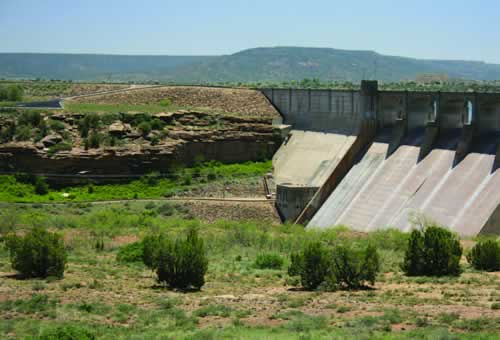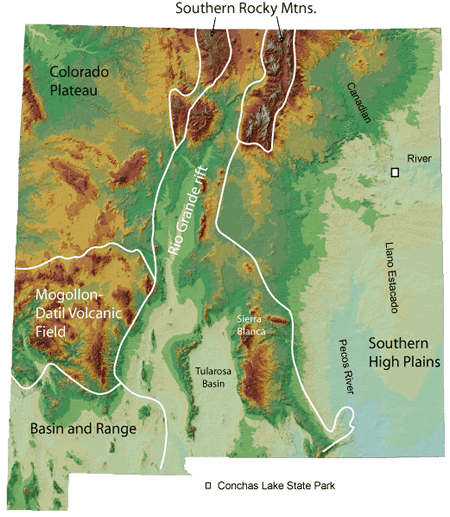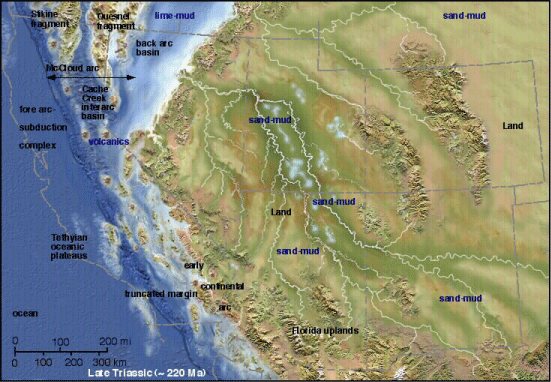
Conchas Lake State Park


L. Greer Price
modified from McLemore, V.T., 1997, Conchas Lake: New Mexico Geology, v. 19, no. 3, p. 76-78.
Introduction
Conchas Lake State Park was established in 1955 and named after the Conchas River, one of the tributaries of the Canadian River. It is 24 mi north of Newkirk and 31 mi northwest of Tucumcari on NM–104 and NM–129 (Fig. 1). Conchas is Spanish for shells and was applied to a group of Indians living in the area when Spanish explorers arrived in the 17th century. The word conchas may be a corrupted name that is confused with the Spanish word conchos, a term also used to describe the Native American tribes in northern New Mexico (Julyan, 1996).
The dam that formed Conchas Lake (Fig. 2) was the 17th dam in the country built by the U.S. Army Corp of Engineers (Young, 1984). One of the state’s oldest dams, it was completed in 1939 to control floods, store water for irrigation and local supplies, and assist in local economic recovery from the Depression (Welsh, 1985). More than 3,000 people were employed to build this concrete and earthen dam that is 235 ft high and 1,250 ft long. The lake has a reservoir capacity of 528,951 acre-ft of water and sediment. It extends 14 mi upstream of the Canadian River and 11 mi upstream of the Conchas River. The total cost of land purchases, construction, and maintenance amounted to nearly $15.8 million (Welsh, 1985; Young, 1984). Water from the lake is used to irrigate 41,400 acres of farmland in the Tucumcari Irrigation Project and travels through 300 mi of canals and laterals.
Regional Setting

Conchas Lake State Park is in the Southern High Plains physiographic province at the north edge of the Llano Estacado or “staked plains” (Fig. 3). This feature extends from the Pecos River on the west to Palo Duro Canyon in Texas on the east and southward to Hobbs, New Mexico, covering an area of about 32,000 mi2 (Reeves, 1972). The origin and meaning of the name Llano Estacado is controversial. Some claim that the name refers to natural stockades created along the rough rim of this plateau, which rises 150 ft above the adjacent plains and river valleys. Estacada is Spanish for palisade or fence, and canyons along the rim became famous as pasture for cattle and horses. Other explanations for the term range from the tall native yuccas resembling stakes at a distance to tales of Indians and later wagon trains from the east marking their routes across this vast, featureless plateau with stakes (Julyan, 1996).
Geology

Most of the rocks surrounding the lake, including those that form the bedrock of the dam, belong to the Upper Triassic Chinle Group. (Fig. 4). The Chinle Group consists of alternating layers of red-brown to maroon to gray mudstone, siltstone, and sandstone that were deposited in continental fluvial and lacustrine environments about 220 million years ago (Fig. 4). Rocks of the Chinle Group were deposited by a river system that flowed from central Texas to central Nevada (Fig. 5). This ancient river system was comparable in size to the modern Mississippi River system. The Chinle Group is divided into five formations in this area: Santa Rosa, Garita Creek, Trujillo, Bull Canyon, and Redonda Formations (Lucas, 1995). The medium- to light-gray, massive to cross-bedded sandstone exposed at the dam was called the Logan Sandstone by earlier geologists, but the unit was never formerly described or named. More recent investigations indicate that it belongs to the Trujillo Formation that extends into west Texas (Lucas et al., 1985; Lucas, 1995; Bureau of Economic Geology, 1977; Finch and Wright, 1983). Mudcracks indicate that sometimes the sandstones were exposed to drying. The red color is produced by the oxidation of iron in the minerals forming the sandstone; this oxidation is common to seasonally arid environments such as existed at the time the Chinle was deposited. Sections of the core drilled and recovered during construction of the dam are on display near the Army Corps of Engineers administration building, north of the spillway.

Channel deposits of gravel and sand derived from the glaciated terrains in the Sangre de Cristo Mountains during the Pleistocene are found along the Canadian River (Figs. 1 and 3) above and below the dam (Spiegel, 1972a, b, c). The Canadian River formed during the Pleistocene after the Wisconsin glaciation. The headwaters are in the Rocky Mountains in Las Animas County, Colorado, northwest of Raton, New Mexico. The river flows southeastward from the headwaters to Raton, where it flows south to Conchas Lake State Park. At Conchas Lake the river flows due east to Ute Lake State Park and eastward into west Texas and Oklahoma. For most of the river’s course in New Mexico, it is a sinuous, meander belt that rarely exceeds 750 ft in width (Kessler, 1972). Floods since 1938 have eroded and degraded the river rather than deposited new stream deposits (Kessler, 1972).
References
- Bureau of Economic Geology, 1977, Geologic atlas of Texas, Tucumcari sheet: Bureau of Economic Geology, University of Texas (Austin), 1 sheet, scale 1: 250,000.
- Finch, W. I., and Wright, J. C., 1983, Measured stratigraphic sections of uranium-bearing Upper Triassic rocks in eastern New Mexico, west Texas, and the Oklahoma Panhandle with brief discussion of stratigraphic problems: U. S. Geological Survey, Open-file Report 83-701, 118 pp.
- Julyan, R., 1996, The place names of New Mexico: University of New Mexico Press, Albuquerque, 385 pp.
- Kessler, L. G., II, 1972, Channel geometry, development, and variation, South Canadian River, eastern New Mexico and West Texas; in Kelley, V. C., and Trauger, F. D. (eds.), East-central New Mexico: New Mexico Geological Society, Guidebook 23, pp. 165–167.
- Lucas, S. G., 1995, Triassic stratigraphy and chronology in New Mexico: New Mexico Geology, v. 17, no. 1, pp. 8–13, 17.
- Lucas, S. G., Hunt, A. P., and Morales, M., 1985, Stratigraphic nomenclature and correlation of Triassic rocks of east-central New Mexico: A preliminary report; in Lucas, S. G., and Zidek, J. (eds.), Santa Rosa–Tucumcari Region: New Mexico Geological Society, Guidebook 36, pp. 171–184.
- Reeves, C. C., Jr., 1972, Tertiary–Quaternary stratigraphy and geomorphology of west Texas and southeastern New Mexico; in Kelley, V. C., and Trauger, F. D. (eds.), East-central New Mexico: New Mexico Geological Society, Guidebook 23, pp. 108–117.
- Scott, G. R., 1986, Historic trails map of the Raton and Springer 30’ ? 60’ quadrangles, New Mexico and Colorado: U. S. Geological Survey, Miscellaneous Map I-1641, 10 pp.
- Spiegel, Z., 1972a, Problems of the Triassic stratigraphy in the Canadian River basin, Quay, San Miguel, and Guadalupe Counties, New Mexico; in Kelley, V. C., and Trauger, F. D. (eds.), East-central New Mexico: New Mexico Geological Society, Socorro, Guidebook 23, pp. 79–83.
- Spiegel, Z., 1972b, Cenozoic geology of the Canadian River valley, New Mexico; in Kelley, V. C., and Trauger, F. D. (eds.), East-central New Mexico: New Mexico Geological Society, Socorro, Guidebook 23, pp. 118–119.
- Spiegel, Z., 1972c, Engineering problems at dam and reservoir sites in east-central New Mexico; in Kelley, V. C., and Trauger, F. D. (eds.), East-central New Mexico: New Mexico Geological Society, Socorro, Guidebook 23, pp. 184–186.
- Wilks, M.E., compiler, 2005, New Mexico Geologic Highway Map: New Mexico Geological Society and New Mexico Bureau of Geology and Mineral Resources, scale1:1,000,000.
- Young, J. V., 1984, The state parks of New Mexico: University of New Mexico Press, Albuquerque, 160 pp.



